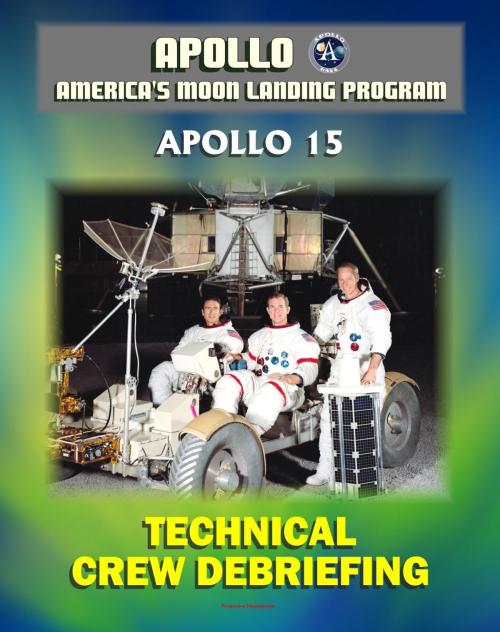Apollo and America's Moon Landing Program: Apollo 15 Technical Crew Debriefing with Unique Observations about the Fourth Lunar Landing - Astronauts Scott, Irwin, Worden
Nonfiction, Science & Nature, Science, Physics, Astronomy| Author: | Progressive Management | ISBN: | 9781466090811 |
| Publisher: | Progressive Management | Publication: | December 12, 2011 |
| Imprint: | Smashwords Edition | Language: | English |
| Author: | Progressive Management |
| ISBN: | 9781466090811 |
| Publisher: | Progressive Management |
| Publication: | December 12, 2011 |
| Imprint: | Smashwords Edition |
| Language: | English |
This official NASA document - converted for accurate flowing-text ebook format reproduction - provides the complete transcription of the Apollo 15 post-flight debriefing given by astronauts, with their first-hand description of the fourth moon landing - featuring the first use of the Lunar Roving Vehicle (LRV). This ebook is an invaluable addition to the library of anyone interested in the Apollo moon landings.
Contents include: SUITING AND INGRESS * STATUS CHECKS AND COUNTDOWN * POWERED FLIGHT * EARTH ORBIT AND SYSTEMS CHECKOUT * TLI THROUGH S-IVB CLOSEOUT * TRANSLUNAR COAST * LOI, DPI, LUNAR MODULE CHECKOUT * LUNAR MODULE CHECKOUT THROUGH SEPARATION * SEPARATION THROUGH LM TOUCHDOWN * LUNAR SURFACE * CSM CIRCUMLUNAR OPERATIONS * LIFTOFF, RENDEZVOUS, AND DOCKING * LUNAR MODULE JETTISON THROUGH TEI * TRANSEARTH COAST * ENTRY * LANDING AND RECOVERY * TRAINING * CSM SYSTEMS OPERATIONS * LUNAR MODULE SYSTEMS OPERATIONS * LRV OPERATIONS * EMU SYSTEMS * FLIGHT EQUIPMENT * FLIGHT DATA FILE * VISUAL SIGHTINGS * PREMISSION PLANNING * MISSION CONTROL * HUMAN FACTORS
Apollo 15 was the first of the Apollo "J" missions capable of a longer stay time on the moon and greater surface mobility. There were four primary objectives falling in the general categories of lunar surface science, lunar orbital science and engineering-operational. The mission objectives were to explore the Hadley-Apennine region, set up and activate lunar surface scientific experiments, make engineering evaluations of new Apollo equipment, and conduct lunar orbital experiments and photographic tasks.
Exploration and geological investigations at the Hadley-Apennine landing site were enhanced by the addition of the Lunar Roving Vehicle, or LRV. Setup of the Apollo Lunar Surface Experiments Package, or ALSEP, was the third in a trio of operating ALSEPs (on Apollos 12, 14 and 15). Orbital science experiments were concentrated in any array of instruments and cameras in the scientific instrument module, or SIM, bay. Engineering and operational objectives included evaluation of modifications to the lunar module, or LM, made for carrying a heavier payload and for a lunar stay time of almost three days. Changes to the Apollo spacesuit and to the portable life support system, or PLSS, were evaluated, and performance of the Lunar Roving Vehicle and the other new J-mission equipment that went with it -- lunar communications relay unit, or LCRU, and the ground-controlled television assembly, or GCTA.
Another major mission objective involved the launching of a Particles and Fields, or P&F, subsatellite into lunar orbit by the command and service module, or CSM, shortly before beginning the return-to-Earth portion of the mission. The subsatellite was designed to investigate the moon's mass and gravitational variations, particle composition of space near the moon and the interaction of the moon's magnetic field with that of Earth.
This official NASA document - converted for accurate flowing-text ebook format reproduction - provides the complete transcription of the Apollo 15 post-flight debriefing given by astronauts, with their first-hand description of the fourth moon landing - featuring the first use of the Lunar Roving Vehicle (LRV). This ebook is an invaluable addition to the library of anyone interested in the Apollo moon landings.
Contents include: SUITING AND INGRESS * STATUS CHECKS AND COUNTDOWN * POWERED FLIGHT * EARTH ORBIT AND SYSTEMS CHECKOUT * TLI THROUGH S-IVB CLOSEOUT * TRANSLUNAR COAST * LOI, DPI, LUNAR MODULE CHECKOUT * LUNAR MODULE CHECKOUT THROUGH SEPARATION * SEPARATION THROUGH LM TOUCHDOWN * LUNAR SURFACE * CSM CIRCUMLUNAR OPERATIONS * LIFTOFF, RENDEZVOUS, AND DOCKING * LUNAR MODULE JETTISON THROUGH TEI * TRANSEARTH COAST * ENTRY * LANDING AND RECOVERY * TRAINING * CSM SYSTEMS OPERATIONS * LUNAR MODULE SYSTEMS OPERATIONS * LRV OPERATIONS * EMU SYSTEMS * FLIGHT EQUIPMENT * FLIGHT DATA FILE * VISUAL SIGHTINGS * PREMISSION PLANNING * MISSION CONTROL * HUMAN FACTORS
Apollo 15 was the first of the Apollo "J" missions capable of a longer stay time on the moon and greater surface mobility. There were four primary objectives falling in the general categories of lunar surface science, lunar orbital science and engineering-operational. The mission objectives were to explore the Hadley-Apennine region, set up and activate lunar surface scientific experiments, make engineering evaluations of new Apollo equipment, and conduct lunar orbital experiments and photographic tasks.
Exploration and geological investigations at the Hadley-Apennine landing site were enhanced by the addition of the Lunar Roving Vehicle, or LRV. Setup of the Apollo Lunar Surface Experiments Package, or ALSEP, was the third in a trio of operating ALSEPs (on Apollos 12, 14 and 15). Orbital science experiments were concentrated in any array of instruments and cameras in the scientific instrument module, or SIM, bay. Engineering and operational objectives included evaluation of modifications to the lunar module, or LM, made for carrying a heavier payload and for a lunar stay time of almost three days. Changes to the Apollo spacesuit and to the portable life support system, or PLSS, were evaluated, and performance of the Lunar Roving Vehicle and the other new J-mission equipment that went with it -- lunar communications relay unit, or LCRU, and the ground-controlled television assembly, or GCTA.
Another major mission objective involved the launching of a Particles and Fields, or P&F, subsatellite into lunar orbit by the command and service module, or CSM, shortly before beginning the return-to-Earth portion of the mission. The subsatellite was designed to investigate the moon's mass and gravitational variations, particle composition of space near the moon and the interaction of the moon's magnetic field with that of Earth.















